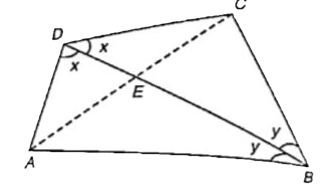Diagonals of a quadrilateral ABCD bisect each other. If ∠A=35∘, determine ∠B.
A
∠B=145∘
B
∠B=115∘
C
∠B=135∘
D
∠B=125∘
Video Solution
Text Solution
The correct Answer is:A
Since, diagonals of a quadrilateral bisect each other, so it is a parallelogram.
Therefore, the sum of interior angles between two parallel lines is 180∘ i.e.,
∠A+∠B=180∘
⇒ ∠B=180∘−∠A=180∘−35∘ [∠A=35∘,given]
⇒ ∠B=145∘
|
Topper's Solved these Questions
Similar Questions
Knowledge Check
Diagonals of a quadrilateral bisect each other. If ∠A=45∘, then ∠ B equals
A45∘B55∘C135∘D115∘Prove that; If the diagonals of a quadrilateral bisect each other at right angles, then it is a rhombus.
ArhombusBtrapeziumCrectangleDkiteThe diagonal BD of a quadrilateral ABCD bisects ∠Band∠D, then :
 AABCD=ADBCBADAB=BCCDCABBC=ADCDDAB=AD×BC
AABCD=ADBCBADAB=BCCDCABBC=ADCDDAB=AD×BC
In a quadrilateral PQRS, the diagonals PR and QS bisect each other. If ∠Q=56∘, determine ∠R.
View SolutionIf diagonal of a quadrilateral bisects each other at right angles then it is a
View SolutionIf the diagonals of a quadrilateral bisect each other at right angle, prove that the quadrilateral is a rhombus.
View SolutionDiagonals of a quadrilateral PQRS bisect each other at right angles. If PQ = 5.5 cm, then the perimeter of PQRS is
View SolutionIf bisectors of ∠Aand∠B of a quadrilateral ABCD intersect each other at P, of ∠Band∠C at Q, of ∠Cand∠D at R and of ∠Dand∠A at S, then PQRS is a
View Solution
